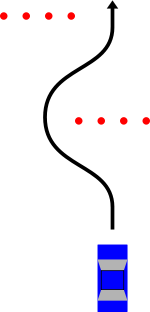Moose test

The evasive manoeuvre test (Swedish: Undanmanöverprov; colloquial: moose test or elk test; Swedish: Älgtest, German: Elchtest) is performed to determine how well a certain vehicle evades a suddenly appearing obstacle. This test has been standardized in ISO 3888-2.[1]
Forms of the test have been performed in Sweden since the 1970s.[2] The colloquial and internationally better-known name for the test was coined in 1997 by the German newspaper Süddeutsche Zeitung after the Swedish motor magazine Teknikens Värld together with the TV-show Trafikmagasinet flipped a Mercedes-Benz A-Class in a test ostensibly made to measure the car's ability to avoid hitting a moose.
In reality, the test is rather constructed to simulate, for example, a reversing car or a child rushing out onto the road.[3][4] This is because it is more likely that the moose will continue across the road than remain in place or turn back, making it more advisable to brake hard and try to slip behind the animal than to swerve in front of it.[5]
Test specifications
The test is performed on a dry road surface. Traffic cones are set up in an S shape to simulate the obstacle, road, and road edges. The car to be tested has one belted person in each available seat and weights in the boot to achieve maximum load.
When the driver comes onto the track, he or she quickly swerves into the oncoming lane to avoid the object and then immediately swerves back to avoid oncoming traffic. The test is repeated at an increased speed until the car skids, knocks down cones, or spins around. This usually happens at speeds of about 70–80 km/h (45–50 mph).
1997 Mercedes A-Class test
On October 21, 1997, the journalist Robert Collin from the motor magazine Teknikens Värld overturned the new Mercedes-Benz A-Class in the moose test at 60 km/h, while a Trabant — a much older, and widely mocked car from the former East Germany — later managed it perfectly.[6] In July 2005, the Dacia Logan appeared initially to fail the test, but a later investigation concluded that excessive testing had worn the car's tyres to failure.
During an interview in Süddeutsche Zeitung, Collin tried to explain this test by the example of an evasive manoeuvre for a moose on the road. It was soon called Elchtest (moose test).[7]
Continued testing
Swedish automotive magazine Teknikens Värld tests "hundreds of cars every year"[2] with the moose test. It publishes test results since 1983 on their web site[8] and the Citroën Xantia Activa V6 has held the record since 1999, beating cars such as the track-oriented 2008 Porsche 911 GT3 RS and the 2017 McLaren 675LT.[9] The slowest car to successfully complete the manoeuvre is listed as the Reliant Rialto at 42.5 km/h, compared to the twice as fast Citroën Xantia at 85 km/h.
The moose-crash test around the world
The moose is common in Sweden, Norway, Finland, northern Russia, Canada, and Alaska, but does not appear in Denmark or Germany. Because of its heavy weight and tall legs, collisions with moose are particularly dangerous for the persons in a car.
Both Volvo and Saab have a tradition of taking moose crashes into account when building cars.[10]
The Swedish National Road and Transport Research Institute has developed a moose crash test dummy called "Mooses". The dummy (which is made with similar weight, centre of gravity and dimensions to a live moose) is used to recreate realistic moose collisions.
Australian car manufacturers use crash test kangaroo dummies for similar reasons.[11]
See also
References
- ^ http://www.vehico.com/index.php/en/applications/iso-lane-change-test
- ^ a b Rabe, Mattias (10 July 2012). "How Jeep Grand Cherokee failed the evasive manoeuvre test". Teknikens Värld. Archived from the original on 13 December 2013.
- ^ Andersson, Sven-Erik (1998-04-14). "Så bra är de nya sommardäcken". Aftonbladet (in Swedish). Archived from the original on 2009-11-22. Retrieved 2012-07-12.
Aldrig tidigare har däck testats i "älgtest" – det test som fick Mercedes A-klass på fall. 40 meters körning mellan koner, och en tvär undanmanöver, som simulerar att till exempel ett barn (inte en älg) plötsligt kommer utspringande framför bilen." / "Never before have tyres been tested in "the moose test" - the test that brought down the Mercedes A-class. 40 meters of driving through cones, and a sharp evasive manoeuvre, that for example simulates a child (not a moose) suddenly rushing in front of the car.
- ^ Collin, Robert (2004-11-15). "Vältklassen". Aftonbladet (in Swedish). Retrieved 2012-07-12.
- ^ "Trafikolyckor & olycksstatistik". Körkortonline.se (in Swedish). Retrieved 13 July 2013.
När en älg väl har börjat gå över vägen är sannolikheten störst att den fortsätter över vägen. Därför är det bäst att styra in bakom älgen, om du måste välja vilket håll du ska väja åt." / "When a moose have begun to cross the road, it is likely that it will continue across. Therefore it is best to stear behind the moose, if you have to choose what way to swerve.
- ^ The Sydney Morning Herald (May 6, 2005). "Petite feat - drive.com.au". The Sydney Morning Herald. drive.com.au. Archived from the original on 19 July 2005. Retrieved 10 January 2012.
- ^ "Der Elchtester". Die Zeit (in German). Retrieved 14 November 2019. (Collin is wrongly spelled as Collins)
- ^ teknikensvarld.se
- ^ "Resultat i Teknikens Världs älgtest". Teknikens Värld (in Swedish). Retrieved 2017-01-13.
- ^ "What Happens When You Actually Hit a Moose? Volvo Has a Moose-Strike Test for That". Car & Driver. Retrieved 3 July 2019.
- ^ "The Ford Discovery Centre". Intown Geelong. Retrieved 9 October 2012.
External links
- Swedish National Road and Transport Research Institute - Moose Crash Test Dummy
- Moose test - list of the fastest and slowest cars
